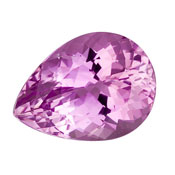Kunzite
(koo nts-ahyt)
HISTORY and LORE
- Kunzite is a relative newcomer to the array of colored stones available for use in jewelry. As the story goes, specimens of an as-yet-unidentified pink crystal were found in San Diego County, California, and sent to Tiffany & Co.’s mineralogist, George Frederick Kunz. The year was 1902. Kunz was able to confirm that the crystals were, in fact, spodumene, but the previously unrecognized color made the find a new variety of the mineral.
- Charles Baskerville, a chemistry professor at the University of North Carolina and later the City College of New York, subsequently named kunzite in honor of George Kunz in 1903.
- In the years since, kunzite has proven to be a highly desirable gem.
VALUE FACTORS
- Color: Occurring in attractive shades of pink to violet, kunzite crystals are also often large.
- Clarity: It is not uncommon to find kunzites that are virtually inclusion-free, so the presence of many eye-visible inclusions will greatly lower its value.
- Cut: Though difficult to cut due to its two cleavage directions, it lends itself to lovely finished gems that show magnificently in fine jewelry. Usually faceted in traditional shapes and styles.
- Carat Weight: It’s not unusual to find kunzite in large sizes. There is an extremely large example that weighs 648.10 carats.
GEMOLOGY
- Kunzite is the best-known variety of the mineral spodumene. It’s named after famed gemologist George Frederick Kunz, who was the first to identify it as a unique variety of spodumene. Kunzite gets its delicate color from trace amounts of manganese. California’s San Diego County is an important source of kunzite.
- Chemical formula LiAlSi2O6.
CARE
Kunzites generally have good wearablility.
- Hardness: Moderate scratch resistance. Rates 6.5 to 7 on the Mohs Hardness Scale.
- Toughness: Kunzite can break under pressure or sharp temperature changes, or fade under heat and bright light.
- Stability: Kunzite’s color can be enhanced by irradiation followed by heat treatment. As with naturally colored kunzite, treated color can fade with exposure to heat and light.
- Cleaning: Warm, soapy water is safe to use when cleaning kunzite jewelry.
